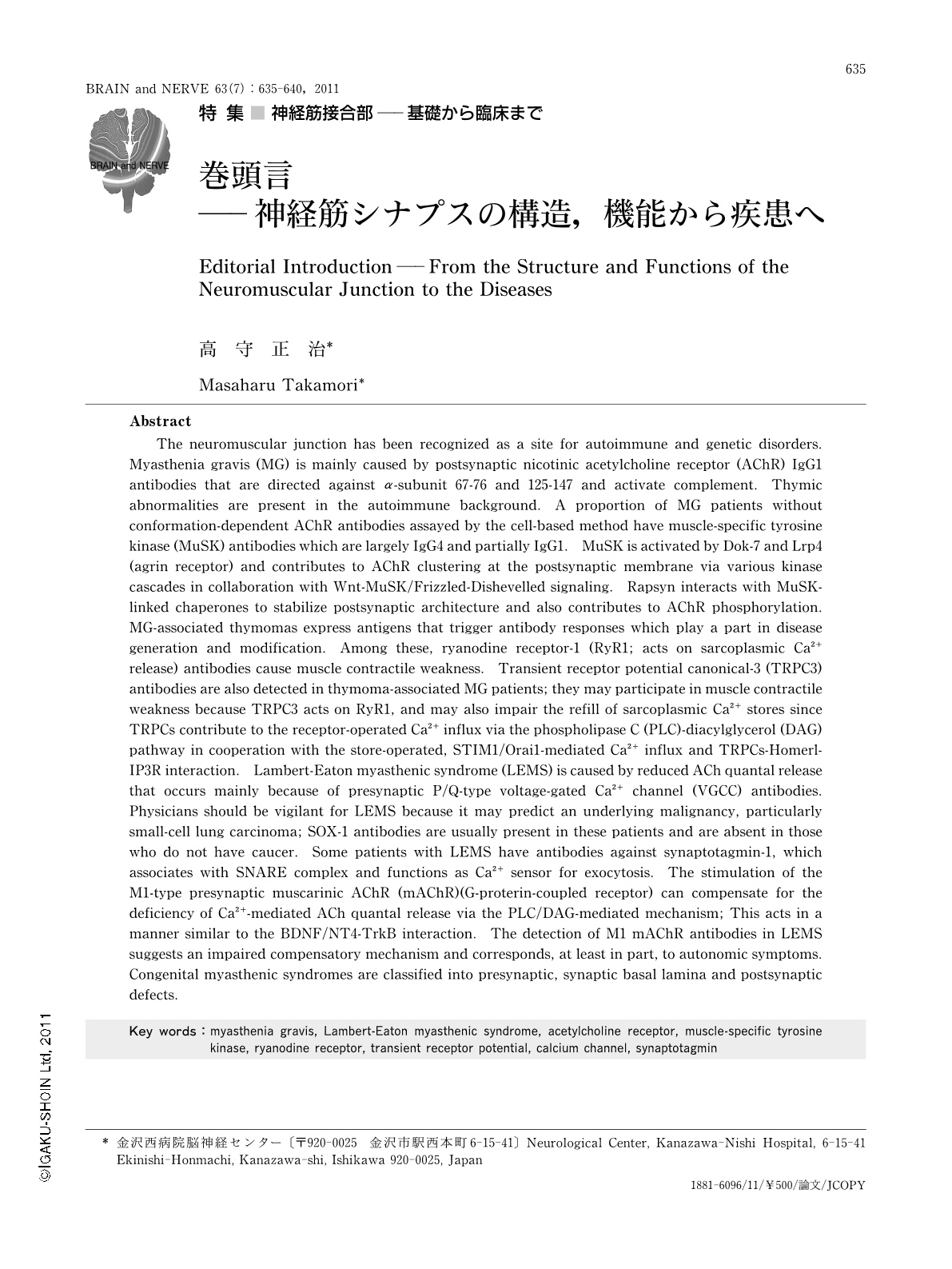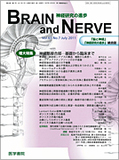Japanese
English
- 有料閲覧
- Abstract 文献概要
- 1ページ目 Look Inside
- 参考文献 Reference
序
神経筋接合部の正常な情報伝達は,神経側のアセチルコリン(acetylcholine:ACh)包含シナプス小胞がdocking,primingのあと融合(開口)するactive zoneと,筋肉側の後シナプス膜上で神経側からの情報を有効に受容すべく群落を形成するアセチルコリン受容体(ACh receptor:AChR)が約50nmのシナプス間げきをはさんでいかに対応するか,その遺伝子制御と分子生物学的構造・機能の様態にかかっている1,2)。この接合部の臨床病態には免疫疾患としての前シナプス病のLambert-Eaton筋無力症候群(Lambert-Eaton myasthenic syndrome:LEMS)と後シナプス病の重症筋無力症(myasthenia gravis:MG),遺伝子疾患としての先天性筋無力症候群がある。
LEMSでは,神経終末P/Q型電位依存性カルシウムチャネル(そのlamininβ2との結合はactive zoneの前シナプス膜面固定に関与4))に対する抗体(特に分子構造上ドメインⅢ,Ⅳ S5~S6リンカー領域を認識,その人工抗原で動物モデル作出可能)が主役を演ずる5-8,10-12)。本病は肺小細胞癌合併頻度が高く13),癌発見より2~5年先行して発症をみることがあり,約10%には小脳失調症を合併する14)。SOX-1抗体は神経筋伝達に直接関係はないが癌合併を示唆する有力な指標となる15)。本病の脇役的病原抗体として,ACh遊離に必須なカルシウム・センサーで,上述のカルシウムチャネル蛋白同様肺癌にその発現が証明されているシナプトタグミン3)に対する抗体(シナプス小胞開口時膜外露呈N端53残基を認識,その人工抗原で動物モデル作出可能)がある8,9,12)。また,G-protein-coupled receptorとしてphospholipase Cシグナル系を介しACh遊離障害を補償する機構17-20)に関わるM1タイプのムスカリン性AChRに対する抗体も高率に検出される16,17)。これは補償障害とともに,本病にみられる自律神経障害16)の背因になっている可能性がある。
Abstract
The neuromuscular junction has been recognized as a site for autoimmune and genetic disorders. Myasthenia gravis (MG) is mainly caused by postsynaptic nicotinic acetylcholine receptor (AChR) IgG1 antibodies that are directed against α-subunit 67-76 and 125-147 and activate complement. Thymic abnormalities are present in the autoimmune background. A proportion of MG patients without conformation-dependent AChR antibodies assayed by the cell-based method have muscle-specific tyrosine kinase (MuSK) antibodies which are largely IgG4 and partially IgG1. MuSK is activated by Dok-7 and Lrp4 (agrin receptor) and contributes to AChR clustering at the postsynaptic membrane via various kinase cascades in collaboration with Wnt-MuSK/Frizzled-Dishevelled signaling. Rapsyn interacts with MuSK-linked chaperones to stabilize postsynaptic architecture and also contributes to AChR phosphorylation. MG-associated thymomas express antigens that trigger antibody responses which play a part in disease generation and modification. Among these,ryanodine receptor-1 (RyR1; acts on sarcoplasmic Ca2+ release) antibodies cause muscle contractile weakness. Transient receptor potential canonical-3 (TRPC3) antibodies are also detected in thymoma-associated MG patients; they may participate in muscle contractile weakness because TRPC3 acts on RyR1,and may also impair the refill of sarcoplasmic Ca2+ stores since TRPCs contribute to the receptor-operated Ca2+ influx via the phospholipase C (PLC)-diacylglycerol (DAG) pathway in cooperation with the store-operated,STIM1/Orai1-mediated Ca2+ influx and TRPCs-Homerl-IP3R interaction. Lambert-Eaton myasthenic syndrome (LEMS) is caused by reduced ACh quantal release that occurs mainly because of presynaptic P/Q-type voltage-gated Ca2+ channel (VGCC) antibodies. Physicians should be vigilant for LEMS because it may predict an underlying malignancy,particularly small-cell lung carcinoma; SOX-1 antibodies are usually present in these patients and are absent in those who do not have caucer. Some patients with LEMS have antibodies against synaptotagmin-1,which associates with SNARE complex and functions as Ca2+ sensor for exocytosis. The stimulation of the M1-type presynaptic muscarinic AChR (mAChR)(G-proterin-coupled receptor) can compensate for the deficiency of Ca2+-mediated ACh quantal release via the PLC/DAG-mediated mechanism; This acts in a manner similar to the BDNF/NT4-TrkB interaction. The detection of M1 mAChR antibodies in LEMS suggests an impaired compensatory mechanism and corresponds,at least in part,to autonomic symptoms. Congenital myasthenic syndromes are classified into presynaptic,synaptic basal lamina and postsynaptic defects.

Copyright © 2011, Igaku-Shoin Ltd. All rights reserved.


